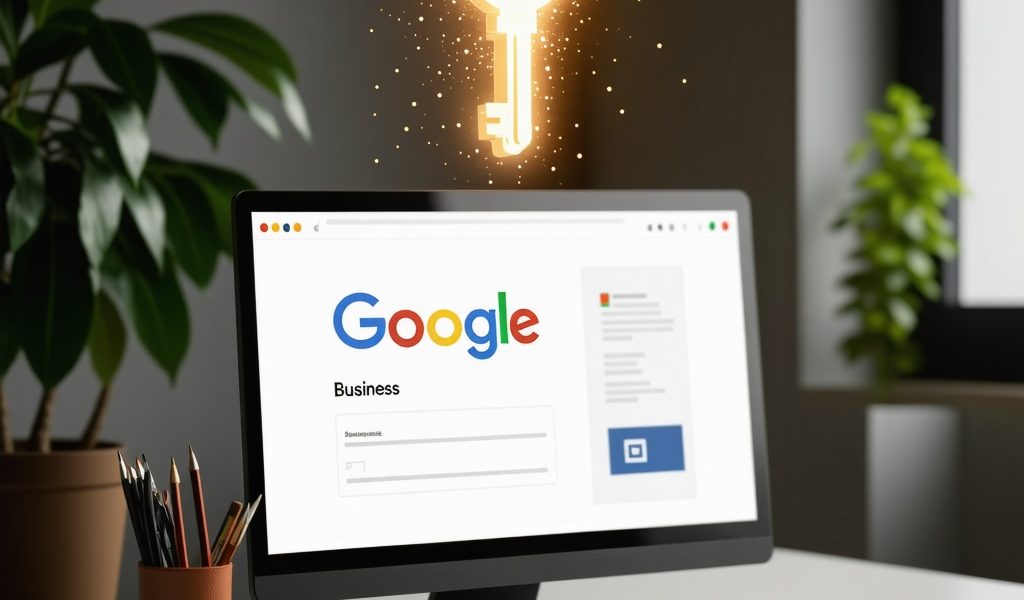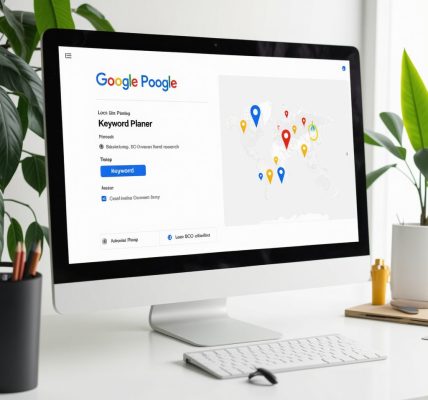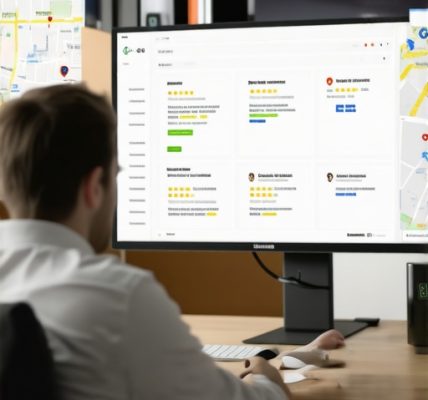Mastering the Art of Keyword Integration in Google Business Descriptions
In the competitive arena of local SEO, your Google Business Profile description serves as a critical touchpoint for potential customers and search engines alike. Unlocking powerful keyword strategies here can transform your online presence, driving targeted traffic and enhancing local visibility. But this is not merely about stuffing keywords—it’s about weaving them naturally into a compelling narrative that resonates with your audience and Google’s algorithms.
Crafting Magnetic Descriptions With Semantic Keyword Relevance
To truly harness the potential of your Google Business description, focus on semantic SEO. This means incorporating Latent Semantic Indexing (LSI) keywords that enrich the context around your primary keywords. For instance, if your main keyword is “Google Business descriptions,” related terms like “local SEO optimization,” “business profile keywords,” and “Google My Business visibility” deepen relevance. This nuanced approach enhances search engine understanding and improves ranking potential.
How Can Strategic Keyword Placement Elevate My Google Business Profile?
Strategic placement involves situating keywords where they have the most impact — typically in the opening sentences and throughout the description without sacrificing readability. Start with a captivating introduction that integrates your primary keyword to grab attention. Then, distribute related keywords naturally to highlight your unique selling points and services. This balance signals to Google the profile’s relevance for specific local queries.
Leveraging Real-World Examples to Illustrate Impact
Consider a local bakery aiming to attract nearby customers. Instead of generic phrases, the description might include keywords like “artisan sourdough bread,” “freshly baked pastries near me,” and “family-owned bakery in [City].” By aligning their description with search intent and local vernacular, they not only engage customers but also improve their chances of appearing in the Google Local 3-Pack. This practical application underscores the transformative power of targeted keyword strategies.
Crafting Descriptions That Build Trust and Authority
Beyond keywords, your description should exude credibility and professionalism. Incorporate phrases that reflect experience and customer-centric values, such as “trusted by local families since 1998” or “award-winning service in [industry].” These narrative elements, combined with keyword optimization, enhance E-E-A-T (Experience, Expertise, Authoritativeness, Trustworthiness)—a critical factor in Google’s ranking algorithms.
For further expert guidance on optimizing your Google Business Profile, explore comprehensive resources like how to optimize your Google Business listing effectively.
Engage, Optimize, and Elevate: Your Next Steps
Implementing powerful keyword strategies in your Google Business descriptions is a dynamic process—monitor performance, refresh keywords, and adapt to evolving search trends. Share your experiences or questions about these strategies in the comments below to foster a community of local SEO excellence. Your insights could inspire others on their journey toward dominating local search results.
Why Monitoring Your Keyword Impact Matters More Than You Think
As I dove deeper into refining my Google Business Profile descriptions, I realized that crafting them was only half the battle. The real game-changer came when I started actively tracking how those keywords performed in driving traffic and engagement. Tools like Google Business Insights gave me a clear snapshot of which keywords resonated most with my audience. If you’re curious about how to track and analyze your GMB performance for continuous growth, resources like this guide have been incredibly helpful in my journey.
Balancing Keyword Optimization Without Sacrificing Authenticity
One challenge I faced was ensuring my descriptions sounded natural and inviting, rather than robotic or keyword-stuffed. I found that storytelling was a powerful tool here — weaving in keywords through authentic narratives about my business’s journey or customer success stories. For example, mentioning “locally sourced ingredients” and “community-focused bakery” naturally incorporated keywords while building trust. This approach aligns with Google’s emphasis on E-E-A-T, reinforcing your profile’s authority and trustworthiness.
How Do You Keep Your Google Business Description Fresh and Engaging Over Time?
That’s a question I often ask myself. The digital landscape and search trends evolve quickly, so updating your description periodically is key. I set reminders to revisit and refresh my keywords every few months, incorporating seasonal offers or new services that reflect what my customers are looking for right now. This continuous optimization not only keeps my profile relevant but also signals to Google that my business is active and engaged.
Learning From Industry Experts and Real Data
I came across an insightful article by Moz that emphasized the importance of semantic keyword integration and user intent in local SEO strategies. They highlight that understanding what your customers actually search for—beyond just exact keywords—can dramatically improve your visibility. This resonated with my personal experience, confirming that blending primary keywords with related terms and local phrases creates a more robust and discoverable profile.
Considering practical tactics and expert advice together has truly elevated how I approach my Google Business descriptions. If you’re eager to dive deeper into crafting compelling profiles, check out this comprehensive guide for actionable insights.
Sharing Your Own Experiences Can Spark Incredible Growth
Have you experimented with keyword strategies in your Google Business descriptions? What successes or hurdles have you encountered? I invite you to share your journey in the comments below. Exchanging stories and tips helps build a supportive SEO community where we all grow stronger together. Plus, if you found this discussion helpful, consider sharing it with fellow local business owners eager to enhance their online presence.
Decoding the Intricacies of User Intent: Beyond Basic Keyword Targeting for Google Business Profiles
While keywords form the backbone of your Google Business Profile description, an expert-level strategy demands a sophisticated understanding of user intent. This means dissecting the underlying motivations behind search queries—whether informational, navigational, or transactional—and tailoring your description to capture these nuances. Instead of merely listing services or products, emphasize how your business solves specific problems or fulfills particular desires that local customers express through their searches.
For example, a local landscaping company might integrate phrases like “eco-friendly garden design solutions” or “emergency tree removal services in [City]”. These not only include keywords but also address precise intents—environmental consciousness and urgent needs—thereby aligning your profile with the searcher’s mindset and increasing conversion likelihood.
Harnessing Latent Semantic Indexing (LSI) Keywords: Crafting Contextual Richness That Elevates SEO
Latent Semantic Indexing keywords are the secret sauce for creating a description that resonates deeply with Google’s algorithmic understanding. These related terms enrich your primary keywords by building a semantic network that signals topical authority and relevance. For example, if your primary keyword is “digital marketing agency,” integrating LSI keywords like “SEO consultancy,” “content strategy experts,” and “local PPC management” can broaden your profile’s reach and relevance.
Expert SEO practitioners often utilize advanced tools such as Ahrefs or SEMrush to uncover these semantic keywords, enabling them to create descriptions that are both comprehensive and naturally engaging. This method also supports Google’s evolving AI-driven search algorithms, which prioritize context and user satisfaction over simple keyword density.
How Can I Effectively Integrate Semantic Keywords Without Compromising Authenticity and Readability?
Striking the delicate balance between SEO and user experience is critical. Start by mapping out your primary keywords and then cluster them with semantically related phrases. Next, weave these clusters into your narrative through natural storytelling or by highlighting unique selling points that inherently contain these terms. Avoid mechanical repetition; instead, employ synonyms, industry jargon, and local vernacular that reflect how your audience talks and thinks.
For instance, instead of repeating “auto repair shop,” you might say “certified vehicle maintenance specialists” or “trusted car service center in downtown [City].” This approach enriches your description’s texture, keeps readers engaged, and signals to Google a multifaceted understanding of your business.
Leveraging Structured Data and Rich Snippets to Amplify Your Google Business Description’s Impact
Beyond textual optimization, incorporating structured data (Schema markup) enhances your Google Business Profile’s visibility and click-through rates. By embedding schema relevant to your business type—such as LocalBusiness, Service, or Product schema—you provide search engines with explicit information about your offerings, location, hours, and reviews.
Rich snippets generated from this data can display in search results as enhanced listings with star ratings, pricing, and availability, offering a compelling reason for users to choose your business over competitors. This technical layer complements your keyword-rich description by reinforcing trust and authority through visible social proof.
For an in-depth guide on implementing structured data for local businesses, refer to Google’s official documentation.
Real-Time Adaptation: Using Analytics and Feedback Loops to Refine Your Keyword Strategy
Advanced optimization doesn’t end with publishing your description. Continuously analyzing performance metrics—such as search queries driving traffic, click-through rates, and customer engagement—allows you to adapt and refine your keyword approach dynamically. Leveraging tools like Google Business Profile Insights and Google Search Console provides actionable intelligence to identify emerging trends or underperforming keywords.
Additionally, actively soliciting and incorporating customer feedback can reveal new keywords and phrases organically used by your audience. For example, if many customers mention “24/7 emergency plumbing” in reviews, integrating that phrase into your description can capture additional relevant searches.
What Metrics Should SEO Experts Prioritize When Measuring Keyword Effectiveness in Google Business Profiles?
Experts recommend focusing on a combination of quantitative and qualitative metrics. Quantitatively, monitor impressions, clicks, and click-through rates for keywords within your profile’s insights. Qualitatively, analyze customer reviews and Q&A sections for recurring language that reveals user priorities and sentiments. This dual approach ensures your keyword strategy remains both data-driven and customer-centric.
For a comprehensive exploration of these metrics, consult Moz’s Local SEO Metrics Guide, a trusted resource among SEO professionals.
Embark on Your Next-Level Optimization Journey
Integrating these advanced concepts into your Google Business description elevates your local SEO game from basic visibility to authoritative presence. By understanding and leveraging user intent, semantic richness, structured data, and continuous analytics, you position your business to dominate competitive search landscapes effectively.
Are you ready to transform your Google Business Profile into a dynamic, intent-driven asset? Dive deeper into these strategies and start experimenting with semantic keyword integration today—your future customers are searching with intent, and your optimized description can be the key to unlocking their trust and business.
Integrating Natural Language Processing for Next-Level Keyword Contextualization
As search engines increasingly rely on Natural Language Processing (NLP) technologies, tailoring your Google Business Profile descriptions to reflect conversational nuances becomes paramount. By aligning your content with how users phrase their queries in natural speech, you not only enhance semantic relevance but also anticipate voice search trends. Embedding contextually rich phrases such as “where can I find reliable emergency plumbing services in [City]?” or “best artisan bakery open late near me” aligns your profile with evolving search paradigms, boosting discoverability.
Strategic Utilization of Competitor Gap Analysis to Uncover Untapped Keyword Opportunities
Expert SEO practitioners employ competitor gap analysis to identify keywords and semantic themes that competitors rank for but are absent from their own profiles. This method unveils underleveraged niches and user intents that can be capitalized on to differentiate your business. Tools like SEMrush’s Keyword Gap feature enable precise identification of these opportunities, allowing you to enrich your description with compelling, targeted phrases that capture overlooked market segments.
How Can Competitor Gap Analysis Refine My Google Business Description Keyword Strategy?
Utilizing competitor gap analysis informs a data-driven approach to semantic keyword integration. By systematically comparing your profile against top-ranking local competitors, you can discern which relevant keywords or user intent topics you might have missed. Incorporating these insights helps craft descriptions that resonate more deeply with potential customers’ queries, while also improving your visibility for a broader range of search terms.
Incorporating Behavioral Data Insights to Enhance Keyword Selection and User Engagement
Advanced local SEO strategies leverage behavioral data—such as click patterns, engagement duration, and conversion rates—to refine keyword focus within Google Business descriptions. These insights enable marketers to prioritize terms that not only attract traffic but also drive meaningful user interactions, thereby increasing the likelihood of conversion. Platforms like Google Analytics and Hotjar provide granular data that can be synthesized to optimize your keyword narrative for maximum ROI.
Balancing Automation and Human Expertise: Leveraging AI Tools Without Losing Authenticity
While AI-driven content generators and SEO tools can expedite keyword research and draft creation, maintaining an authentic and personalized voice remains a critical differentiator. Expert optimizers recommend using AI outputs as a foundational scaffold, subsequently refining content with human insights to ensure tone, nuance, and brand identity are preserved. This hybrid approach harnesses efficiency without compromising the trustworthiness and engagement value of your Google Business Profile.
For an authoritative deep dive into advanced local SEO analytics, consider Moz’s expert insights on Local SEO Metrics Guide, recognized for its comprehensive coverage of performance measurement best practices.
Invitation to Elevate Your Local SEO Mastery
Are you prepared to transcend basic keyword tactics and embrace a sophisticated, data-driven approach to optimizing your Google Business Profile? Engage with these advanced strategies to unlock new dimensions of search relevance and customer engagement. Share your experiences, challenges, or successes with semantic keyword integration and analytics in the comments, or connect with our community to refine your local SEO expertise continuously.
Frequently Asked Questions (FAQ)
What are the key differences between primary keywords and Latent Semantic Indexing (LSI) keywords in Google Business descriptions?
Primary keywords are the main terms that directly reflect your business’s core offerings or identity, such as “digital marketing agency.” LSI keywords are semantically related phrases that provide context and depth, like “SEO consultancy” or “content strategy experts.” Incorporating both ensures your description is comprehensive, resonates with varied search intents, and aligns with Google’s contextual understanding.
How can understanding user intent improve the effectiveness of my Google Business Profile description?
Understanding user intent means recognizing whether searchers seek information, navigation, or a transaction. Tailoring your description to address these intents—such as highlighting emergency services for urgent needs or detailed benefits for informational queries—makes your profile more relevant and increases conversion potential by directly addressing what customers are truly looking for.
What role does structured data (Schema markup) play in enhancing my Google Business listing?
Structured data provides explicit information to search engines about your business, such as type, location, products, and reviews. This enables rich snippets in search results—like star ratings and pricing—that improve visibility, credibility, and click-through rates, complementing your keyword-rich description with authoritative signals.
How frequently should I update my Google Business description to maintain SEO effectiveness?
Updating your description every few months is advisable to reflect new services, seasonal offers, or emerging keywords. Regular refreshes signal to Google that your business is active and engaged, helping maintain relevance in evolving search landscapes and adapting to shifting user behaviors.
Can competitor gap analysis really uncover valuable keyword opportunities for my profile?
Absolutely. Competitor gap analysis identifies keywords and topics your competitors rank for but you currently omit. Utilizing tools like SEMrush’s Keyword Gap allows you to discover underutilized keywords and user intents, enabling you to differentiate your profile and capture additional relevant search traffic.
How do I balance keyword optimization with maintaining an authentic and engaging tone?
Integrate keywords naturally through authentic storytelling, customer success narratives, and localized language. Avoid mechanical repetition by using synonyms and conversational phrases that reflect your brand voice. This approach enhances readability and trustworthiness, aligning with Google’s E-E-A-T principles.
What metrics should I prioritize to measure the success of my keyword strategy on Google Business?
Focus on impressions, clicks, and click-through rates from Google Business Profile Insights, complemented by qualitative analysis of customer reviews and Q&A language. This combined approach reveals both the quantitative reach and qualitative resonance of your keywords, guiding data-driven refinements.
How can Natural Language Processing (NLP) impact my keyword strategy for voice search?
NLP enables search engines to interpret conversational queries and context. Adapting your description with natural, question-based phrases and conversational language improves alignment with voice search trends, enhancing discoverability for spoken queries and long-tail conversational keywords.
Should I rely solely on AI tools for crafting my Google Business description?
While AI tools can streamline keyword research and initial drafts, human expertise is essential to ensure authenticity, brand voice, and nuanced messaging. Combining AI efficiency with human refinement achieves content that is both optimized and trustworthy.
How can behavioral data refine my keyword focus and user engagement?
Analyzing user interactions such as click patterns, engagement duration, and conversions helps prioritize keywords that drive meaningful actions. Tools like Google Analytics and Hotjar provide insights to tailor your description towards terms that not only attract traffic but also encourage customer engagement and conversion.
Trusted External Sources
- Google Developers – Structured Data for Local Businesses: Offers authoritative documentation on implementing Schema markup to enhance local SEO and generate rich snippets, critical for reinforcing your Google Business Profile’s visibility and trustworthiness.
- Moz – Local SEO Metrics Guide: A comprehensive resource that details which quantitative and qualitative metrics to monitor for measuring the success of local SEO and keyword strategies, helping optimize performance effectively.
- Ahrefs Blog – LSI Keywords Explained: Provides expert insights and practical techniques for discovering and integrating Latent Semantic Indexing keywords, essential for crafting semantically rich and contextually relevant business descriptions.
- SEMrush – Competitor Keyword Gap Analysis Tool: An industry-leading platform for identifying untapped keyword opportunities by comparing your profile against competitors, facilitating data-driven enhancements to your local SEO strategy.
- Google Business Profile Help Center: The official resource for best practices and updates on managing and optimizing your Google Business Profile, ensuring you stay aligned with Google’s evolving guidelines and features.
Conclusion
Optimizing your Google Business Profile description with advanced keyword integration techniques is pivotal for standing out in local search results. By strategically combining primary and LSI keywords, addressing nuanced user intent, leveraging structured data, and continuously refining through analytics and competitor insights, you create a dynamic and authoritative profile that resonates with both customers and search engines. Balancing automation with authentic storytelling preserves your brand’s unique voice while maximizing SEO impact. Embrace these expert strategies to elevate your local visibility, build trust, and drive meaningful engagement. Start applying these insights today, share your progress, and explore related expert content to master the art of local SEO excellence.



